|
.
This
is the first of two interviews with Colin Bryan, this one about the
Shockwave which in 2004 was celebrating its tenth anniversary.
Click
here for our follow-up interview conducted in January 2006.
It’s
easy to be overwhelmed by the grandeur of the Shockwave
majestically towering over the lakeside below and think of
Drayton Manor Park as always having been a big player, but
it’s just as easy to forget that this coaster was a
multi-million pound investment for a what was a small,
family-run park.
This
isn’t to belittle the heritage behind Drayton Manor, though.
Despite 45 years of history, Drayton Manor had maintained a
fairly subdued image despite investment in rides such as Pirate
Adventure and the Log Flume.
But
up until 1994, most people beyond the borders of Staffordshire
remained largely ignorant to Drayton Manor, but a stand up
roller coaster was about to send shockwaves not only through the
park, but the country too.
Shockwave
opened in 1994, ‘Year of the Roller Coaster’, along with
Alton Towers’ Nemesis (Bolliger and Mabillard Inverted) and
Pleasure Beach Blackpool’s Pepsi Max Big One (Arrow Dynamics
Mega Coaster). Whist Shockwave was forced to share the limelight
with these two coasters, there is no denying the fact that
Shockwave helped bring a park with nearly half a century of
history to peoples’ attention and undoubtedly shaped the park
we see today.
To
most people, it wasn’t just Shockwave that was new to them in
1994 – it was the entire park.
Since
Shockwave, the Bryan family have exhibited unwavering commitment
to investing in the park with unique and attention-grabbing
rides such as Apocalypse (Intamin Giant Drop) and Stormforce 10
(Bear/ABC Flume).
So,
in 2004, as Shockwave celebrates its tenth anniversary, Coaster
Kingdom uses this opportune time to ask Colin Bryan, Managing
Director and Family Owner of Drayton Manor park about the last
10 years, the effect Shockwave has had and what he envisages for
the next decade.
Coaster
Kingdom (CK): When
was it first decided that Drayton Manor required a major ride in
1994?
Colin
Bryan (CB): “Requirement
was about 1982, when Alton Towers acquired corkscrew! 1990 we
had Pirate's Advenutre, still keeping with the family theme. It
was not until 1992 that the two rides; Splash Canyon and
Shockwave were decided to go together in 1993/1994. Concrete for
Shockwave was laid in the 1992 winter build of Splash Canyon; in
fact £1 million worth of concrete is in Splash and Shockwave
anchor points in the ground.”
|
|
 The
choice was either stand-up or ordinary sit-down
The
choice was either stand-up or ordinary sit-down

|
|
CK:
How much was the choice of stand up coaster influenced by the
ability to combine it with a family ride, Splash Canyon?
CB:
“The two had to go into a limited site size. Because of
limitations of planning as well this was the only way we could
get in two rides to get us up with the major parks for capacity
and recognition. The choice was either stand-up or ordinary
standard sit-down. Height did also come into planning – no
more than the height of Shockwave was possible.”
CK:
So before the idea of a stand up coaster was pursued, what
other types of ride were considered? Was a roller coaster your
only consideration, and if so, what alternative types to the
stand up considered?
CB:
“In 1992 even hanging coasters were rare. We did not know that
Alton Towers was going to do a hanging (undersling) coaster. The
stand-up was an Intamin stand and was ordered at the show in IAAPA
for delivery in autumn of 1993. Previously 1992 was the same
time scale for Splash Canyon i.e. Intamin rapids ride.”
CK:
What other rides was Shockwave inspired by? And how do you go
about researching what could be successful at Drayton Manor?
CB:
There were no others to inspire as all others were two-across;
Shockwave is four-across. Newer rides are either so unique to us
and to UK. Sweden had one and in 1993 we went and filmed our
advert over there. To get the feel for it and to plug ours on
TV, the Sommerland stand-up was plastered with Drayton Manor
Park stickers on it. (This coaster is now in La Ronde)
CK:
Why did you specifically choose the stand up coaster? Was it
because the design was more marketable as a ride, or because of
the ride sensation?
CB:
“Unique and not an off shelf coaster. Unique - 1st
stand up in the world for inversions, with the heart line
spiral.”
|
|
 What
is 'off the shelf'
What
is 'off the shelf'
anyway?

|
|
CK:
So you specifically elected to avoid an off-the-shelf coaster,
then?
CB:
“Off the shelf coasters were not suitable as “what is off
the shelf anyway?” We needed a big job and got one. It could
have been bigger if we had more money and only that factor, but
today we would have suffered by the lack of land available for
the plethora of rides now in the park. As said planning
restrictions required us to only occupy the current position.”
CK:
Who else other than the manufacturer and park were involved in
Shockwave?
CB:
“Eight contractors none actually involved in design of ride.
Mainly concrete, building and access repair department and all
other items except roller coaster design, as Intamin had
exclusivity.”
|
1994:
Year of the Roller Coaster
Other
coasters opening in 1994
|
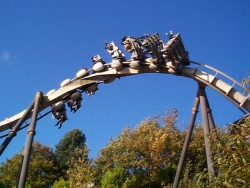 |
|
Nemesis
at Alton Towers |
|
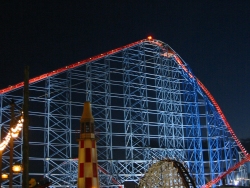 |
|
Big
One at Pleasure Beach Blackpool |
|
|
|
CK:
How aware were you that the UK theme park industry was about to
take off and that Drayton Manor needed something to capture
peoples’ imagination?
CB:
“We did not seem to know that Alton Towers and Blackpool were
putting in mega coasters for 1994.
Perhaps
we may have triggered the race by ordering ours in 1992/3 - yet
if speaking to John Wardley he will be only too aware that he
kept quiet about his and we didn't. They were designed by the
Swiss; ours Intamin, theirs by B&M and yet both were once
all one company!
And
yes, it was an amazing year in 1994: "The Year of the
Rollercoaster".”
CK:
Although it was an amazing year, the prospect of opening
Shockwave within weeks of two other major coasters must have had
an affect on the way you marketed the ride?
CB:
“Saturday March 26 1994 we launched with the Gladiators and
even had page 3 in the Sun - priceless! Shockwave lived up to
its name!”
CK:
Some parks are very specific in their requirements for a new
ride, whilst others give manufacturers a free reign. How much
time did you spend developing Shockwave, and how involved were
you in the design?
CB:
“Time taken 2 years. We helped with design and configuration
only on paper. Size and available area were the major deciding
factors. The ride could not go outside the area already
designated as into "green belt". So length played a
lot in the number of spirals achievable from the height
available, i.e. drop down only allowed so much run up to the
exit, if higher then more track needed and therefore more land
taken up!
|
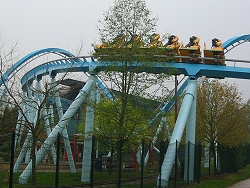
|
| The
final turn, pictured, would have looked different had the council
not misread the plans |
|
CK:
So the planning restrictions are more specific than just the
visual impact the ride has then?
CB:
“Yes. The access road, lake, car parks and local housing
played significantly in the ‘restraint’ put upon by the
local council. Afterwards when the ride was finished the locals
complained about the closeness of the last bend before the
station being so close to the boundary of the park, saying it
was not on the plans. Well, they had passed it absolutely
correctly to the millimetre and the council had not noticed how
close Shockwave track HAD been drawn and subsequently built so
close to the edge of the property, stream and car parks. This
could not happen now, as the digital map references would be
bought to the councillor's attention straight away.”
CK:
What direct affect did these restraints have on Shockwave?
CB:
“Height and length. An extra Bayuurn curve would have been
nice, out over the lake,
but not enough height to allow build to go ahead.”
CK:
Any other ideas that didn’t make it to fruition?
CB:
“Yes, also considered was one stand-up car and one sit down
(same as Busch Gardens sit down mega 4 across coaster).”
|
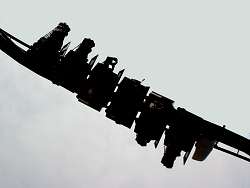
|
| The
heartline spiral, pictured, had to be replaced |
|
CK:
With such a large project, you must have encountered a fair
amount of hurdles?
CB:
“The new (for stand up) "heart line spiral". Two
pieces of pipe were bent and when the ride was finished
construction the test rig would not go through so another pipe
(i.e. a complete length of track) was put in place of the
useless length of track.
Also
the tonnage of the ride and its size for craneage, amount of
concrete; i.e., £1 million worth in the ground.”
CK:
We’re talking big money then for a family park.
CB:
“Yes, the crash of black Wednesday on the stock market in
October 1993 caused us to lose £600,000 on the deal with the
two rides, a total of £7million expenditure in the end over
three years.
Always
overestimate the costs of installation as no one gets it
right.”
CK:
But you saved money elsewhere, right?
CB:
The building was the first case in the UK for tax allowances to
be allowed as part of the ride. So the whole of the ride and the
access stairs/building were classed as one amount and not as a
separate building and ride as is in most cases.
A
building is not tax allowable (offset against profit of company,
therefore, less tax to pay). DMP were the first company to do
this, therefore, set the president forever. Now all high roller
coasters that have a building as part of the access and store
get tax allowance as one. Previously only if the ride arrives
with an "as supplied" completed ride do others get
this tax allowance. If the building is not supplied in the
price, then no tax allowance.”
CK:
Retrospectively, is there anything you would change about
Shockwave?
|
|
 We
should have had a Nemesis-style coaster
We
should have had a Nemesis-style coaster

|
|
CB:
“Yes. We should have had a Nemesis-style coaster and
not stand up. At the time we ordered ours, stand up was to be
the best thing and now 10 years later it’s the rarest of
coasters – there’s still only 15 in the world”
CK:
But it’s still unique though?
CB:
“Yes, the Heartline spiral was unique at the time and its
popular still after 10 years.”
CK:
Shockwave is now one of four major rides in the park to come
from ride manufacturers Intamin. To what extent did the
experience of working with them influence the choice of later
rides?
CB:
“Splash Canyon (1993), Shockwave (1994), Apocalypse (1999) and
Maelstrom (2002) - You forgot the Flying Dutchman (1983). This
is the ONLY one in the world now as only 4 built and 3 scrapped!
Uses
hydraulics (Yale, USA), drive (STAFFA, UK), French steel for
arms, boats from Austria and ropes (for cars) from the UK. A
very international ride.
What
influenced us? High usage and longevity and very important
inventiveness.
We
have a good relationship with Intamin and they with us. Although
they are always expensive they offer very fair value in the long
run.”
|
Intamin
and Drayton Manor
 We
have a good relationship with Intamin
We
have a good relationship with Intamin

|
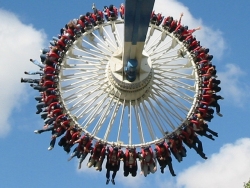 |
|
Maelstrom:
2002 |
|
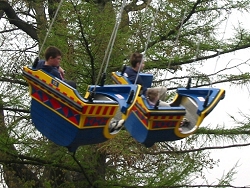 |
|
Flying
Dutchman: 1983 |
|
|
|
CK:
What rides have caught your attention within the last decade?
CB:
"Top Thrill Dragster", Cedar Point, not that I would
go on it, but its sheer design and ingenuity are amazing.
CK:
And the next ten years...?
CB:
“Have not a clue. The last 10 years has surprised me every
year and the next 10 will as well. Perhaps, Mission: SPACE
(Epcot), Top Thrill Dragster number 2 over 500 ft? But make sure
that its safe whatever is done.
There
will be (my prediction) less theme parks, and less people
visiting the UK industry in the future, basically because:
Age:
(in 2010) there will be more over 60 years old than under 16
years of age. This alters the ride requirements and less
therefore revenue.
Time
available: congestion, travel and prior engagements will make us
not want to go out.
Other
activities: Our most feared opposition is Sunday mall shopping.
This alone is our biggest opposition.
And
finally, the single parent will not be able to afford us. A bad
prediction yet has to be put down as a factor.”
CK:
What do the UK Government do to help in this respect?
CB:
“Government intervention in all the following makes us feel
more restricted and ruled.
VAT
@ 17.5% is unjust in the UK on the entrance price, fast food
(burger to eat on hoof), overnight accommodation and restaurant
meals.
All
EU countries except UK (17.5%) and Denmark (19.6 or 21%) are 6%
for entrance, fast food and accommodation. France is 5.5% on
restaurant meals served. How unjust can that be?
HSE
[Health and Safety Executive] are over zealous and awfully power
crazy. It now needs reigning in and stopping adding any more
regulations as they (HSE) are asking for more regulations than,
say, in Germany. If a German ride is accepted in Germany and all
over the world why should HSE and others ask for more
regulations to come to the UK, it is daft and not needed.
After
all a Mercedes is not altered by country for each country
surely.”
|